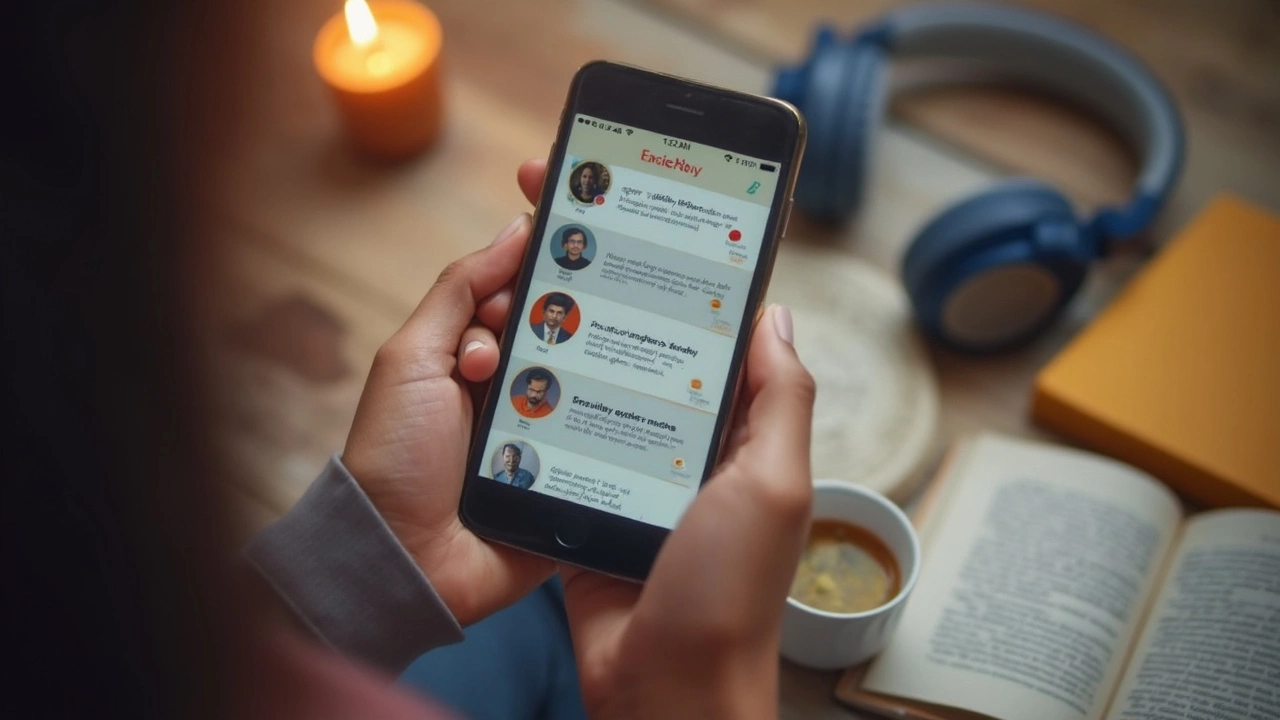Ever searched “free app for speaking English fluently” and felt lost in a sea of promos? You're not alone. Most apps throw around words like 'free,' but tuck the real juicy stuff behind paywalls.
Here’s what actually works: focus on apps that connect you with real people or use smart AI for real conversation practice. Talking, not just tapping. For instance, apps like Duolingo and HelloTalk let you chat with native speakers or practice out loud without paying for the privilege. The trick is knowing which parts are really free and how to squeeze the most out of them.
If you want to sound less like a textbook and more like a local, picking the right app saves time and frustration. Some apps even give instant feedback if you say something weird—way more helpful than repeating after a robot. Before you pay anyone, let’s break down which options let you talk, listen, and get better in real English. You can start speaking today, with just a phone and some motivation. No credit card required.
- Why Free English Speaking Apps Matter
- Top Free App Reviewed: Is It Really Free?
- Standout Features: What Helps You Actually Speak
- Real-Life Tips to Use These Apps Effectively
- Common Pitfalls and How to Dodge Them
Why Free English Speaking Apps Matter
Getting better at speaking English can seriously change your life. It opens doors to better jobs, lets you connect with people from all over, and just makes travel easier. But let’s be real—private classes or fancy paid apps can cost a lot. That’s why finding a free English speaking app that actually helps you talk, not just memorize, is a big deal.
More than 1.5 billion people worldwide are learning English, according to a 2024 report by Education First. Most learners aren’t in countries where English is spoken every day. Free apps step in here—they make real-world English practice possible from anywhere, with just your phone.
| Thing You Get With Free Apps | Why It Matters |
|---|---|
| Practice speaking any time, day or night | No need to fit someone's schedule |
| Mix of native speakers and learners | Learn different accents, real phrases |
| Zero cost | No financial barrier, try as much as you want |
| Feedback or correction | Avoid building bad habits early on |
Here’s something not everyone tells you: most learners quit not because of boredom, but because they don’t see real progress. Free speaking apps let you keep practicing until stuff clicks—no pressure to “make the most” of a paid subscription.
- Start casual chats with people you’d never meet otherwise.
- Get over the fear of making mistakes, since nobody’s watching in a classroom.
- Turn awkward silences into real learning moments, instead of worrying what people might think.
That convenience and lack of stress can make you stick with it day after day. It’s not about replacing a real teacher—it's about adding the practice you need to finally feel comfortable speaking English on the spot.
Top Free App Reviewed: Is It Really Free?
It’s easy to get hyped about a shiny new speaking app, but how many are truly free? Let's talk real numbers and features. In 2025, the most mentioned name when searching for a free English speaking app is HelloTalk—and for good reason. HelloTalk lets you chat, send voice notes, and even do voice calls with real people across the world, all for zero cost. This isn’t just a short demo or a seven-day trial; you can stick around and get better without being forced to upgrade.
Not far behind, you’ve got apps like Duolingo and Cake. Duolingo leans hard into gamified learning. Here’s the catch: while it’s totally free for daily lessons, its speaking practice is a bit more limited compared to HelloTalk. Cake is all about practicing with real videos and seeing how people really talk—great for hearing slang and common phrases. But actually speaking back is more on you, not the app.
Here's a quick breakdown of what you get for free in these popular apps:
| App | Free Speaking Lessons | Chat With Natives | Unlimited Voice Messages | Annoying Ads? |
|---|---|---|---|---|
| HelloTalk | Yes | Yes | Yes | Sometimes |
| Duolingo | Limited | No | Not really | Yes |
| Cake | Yes (video-based) | No | No | Sometimes |
Notice the differences. HelloTalk has the edge for people who want to actually talk, not just repeat phrases to an AI. Duolingo’s free tier is good for basics but limits you when it comes to real conversations. Cake is solid for listening but doesn’t match HelloTalk for speaking practice.
There’s always some compromise with free apps. You might see ads, and sometimes premium features get teased in your face. But you don’t need to spend to make serious progress in fluency. Just dig a bit, use the free parts well, and mix it up with more than one app if you need to.

Standout Features: What Helps You Actually Speak
Not every language app is worth your time if your real goal is to be chatty in English. The truth is, only a handful of features actually help you get talking. Here’s what you should look for in any free English speaking app if you want to boost your speaking skills instead of just staring at screens.
First, speech recognition is a game changer. Apps like Duolingo speak back to you and let you repeat phrases, then they judge your accent and tell you if you messed up. It’s not perfect, but it’s way better than guessing if you sound right. Real-time feedback keeps you honest.
Next, look for apps that match you with real people. For example, HelloTalk is huge in this space. It lets you chat by text, audio, or even live calls with native speakers or learners around the world. This is where you tackle your nerves and get used to real conversations, not just guessing what a robot wants to hear.
Group chat features can also help. Some apps have digital “rooms” where people hop in to talk about everything from travel to food. This lets you jump into group talks or listen in, so you catch slang and real accents. Plus, when you speak up, there’s less pressure than a one-on-one.
- Speech recognition for real feedback
- Live chat with learners and native speakers
- Group conversation rooms
- Practice with real topics, not just *hello, how are you*
- Daily reminders to keep you coming back
Here’s another important bit—instant corrections. The best apps don’t just let you talk; they also let partners correct your words or pronunciation in real time. No more building up bad habits without even knowing. If you get stuck, some platforms offer translation as a backup so you’re never totally lost.
The boring stuff matters, too. An app that tracks your progress and shows what skills you’re improving keeps you motivated. And if it has lessons based on your level, you won’t feel like you’re drowning in grammar you’re not ready for.
The bottom line: the right features save you from wasting time repeating phrases you’ll never use. They get you actually speaking, listening, and thinking in English in ways that matter outside the app.
Real-Life Tips to Use These Apps Effectively
Don’t just install an app and expect magic. Consistency beats cramming, every single time. Studies show that practicing 15-30 minutes a day leads to better improvement than one marathon session every weekend. So, set a daily reminder. Treat this like a fitness routine for your brain.
Say everything out loud. Silent tapping won’t boost your speaking skills. Most good apps (like HelloTalk and Duolingo) now have a 'speaking' mode—use it. Your phone doesn’t care how you sound, but your ears definitely will. Actually hearing yourself is a game changer.
Jump into real conversations if the app allows it. HelloTalk, for example, matches you with native speakers who correct your words and pronunciation for free. Nervous? Start by sending voice notes instead of live calls. It’s less scary and gives you time to think before talking.
- Turn on speaking exercises as early as possible, even if you feel stuck at the basics. Don’t wait till you’re “ready.”
- Record yourself. Listening back, you’ll spot pronunciation problems faster (and laugh at your early mistakes later).
- Make mistakes on purpose sometimes—see how the app corrects you. It’s a safe place to get things wrong and actually remember the lesson.
- Mix in different topics every few days. Don’t just stick with what feels easy or fun—experiment with new categories, like news or daily routines, to sound more natural.
Stick to one main app for your free English speaking app, rather than bouncing between six. You want to build real progress, not collect badges. If you’re using HelloTalk or Tandem, message three new people a week. Small goals work better than chasing instant fluency.
Last tip: Double-check your app’s settings for daily reminders or streaks. These seem silly, but research proves they trigger habit loops that help you show up, which is half the battle in speaking better English.

Common Pitfalls and How to Dodge Them
Downloading a free English speaking app feels like a win—until you hit a wall. Plenty of folks start strong and then drop off. Why? Because easy mistakes can mess with your progress way before you see real results.
One big trap: just passively scrolling or only doing listening exercises. Apps can make you feel productive, but if your mouth isn’t moving, you’re not really practicing speaking. Another issue is sticking to only one type of exercise. Real conversations are messy, fast, and sometimes unpredictable. Only repeating phrases or doing fill-in-the-blanks won’t cut it for fluency.
Lots of apps also rely on spaced repetition, but science shows that mixing up practice types builds memory faster. If you only focus on single words without using them in full sentences, your brain doesn’t link them together. Plus, some people get discouraged by not sounding perfect and quit early. Native-level English takes time—studies say it can take 600-750 hours of deliberate practice for speakers of similar languages.
- Mute mode won’t help: Don’t rely on silent practice. Speak out loud—even if it feels awkward at first.
- Don’t skip feedback: Some apps offer real-time corrections. Use it instead of racing ahead.
- Set micro-goals: Challenge yourself to have a 2-minute daily conversation or send an audio message each day.
- Vary your practice: Mix chatting, pronunciation games, and sentence building. Don’t just memorize vocab lists.
- Stay social: Language is social, so connect with real people via chat or call features when possible.
To see how users trip up, check out this quick look at dropout rates in language learning apps:
| Common Pitfall | Users Affected (%) |
|---|---|
| Passive learning only | 45 |
| Lack of speaking out loud | 38 |
| Not using feedback | 30 |
| Boredom with repetition | 27 |
If you catch yourself falling into any of these, tweak your routine. A few adjustments—like forcing yourself to pronounce every new word out loud or sending a quick voice note—lead to major improvements. The way you use the app matters way more than which app you choose.


